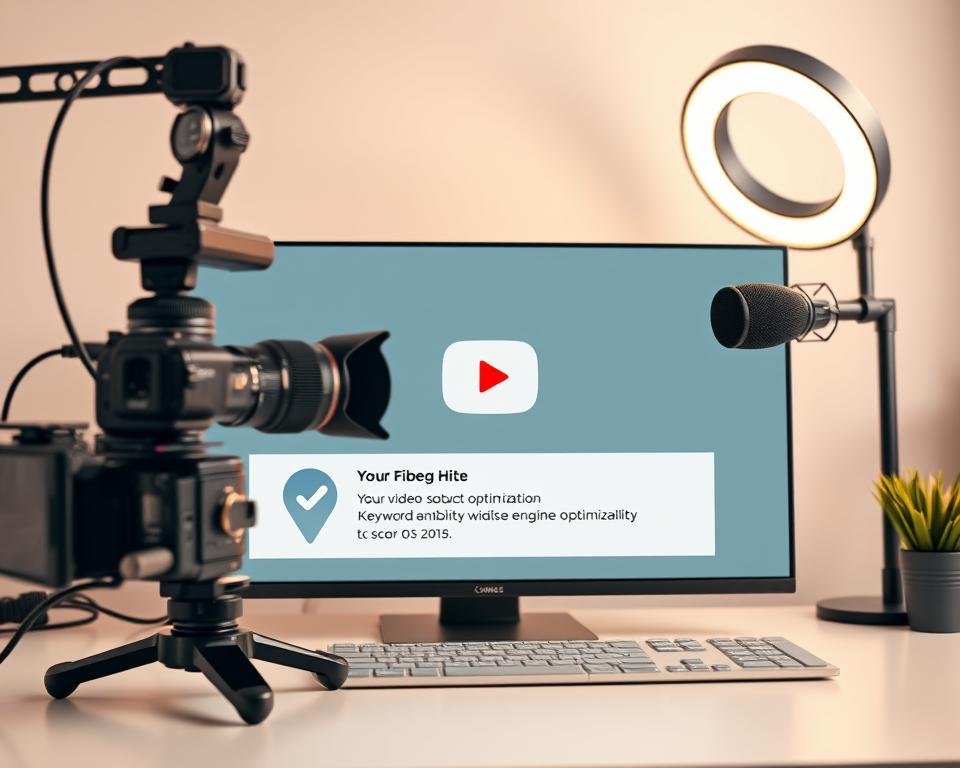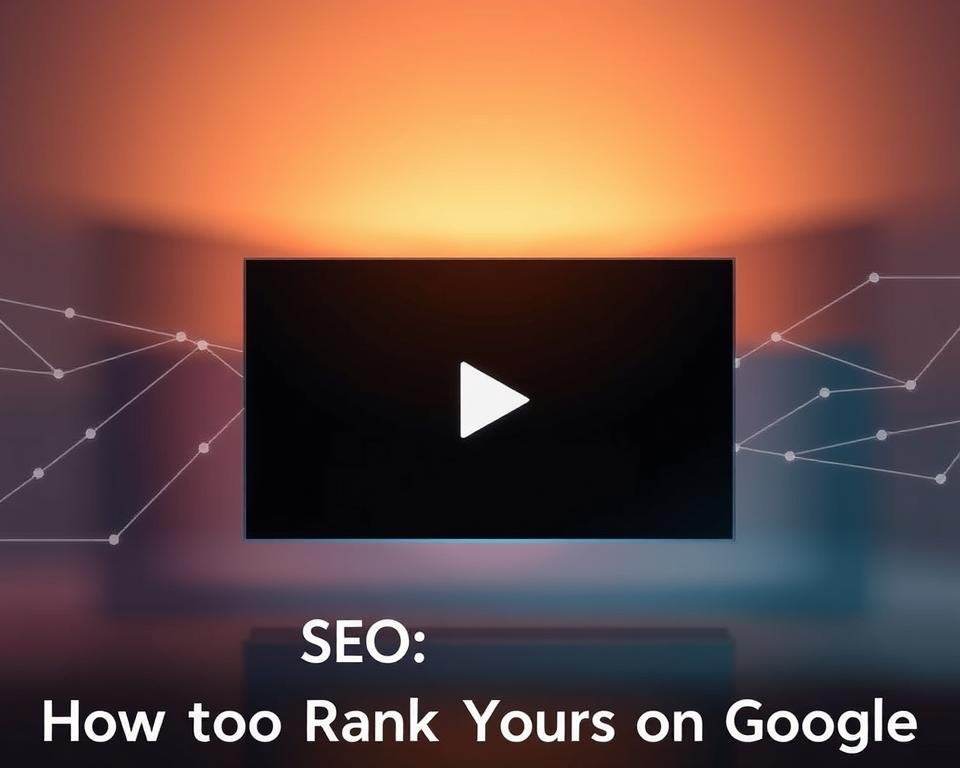I’ve learned how important it is to make my online content easy for search engines to find. With so many people online, it’s key to stand out and grab attention.
Getting your videos to show up on Google starts with good video optimization. By using smart strategies, I can get more people to see my content. Here, I’ll share tips on how to do just that.
Key Takeaways
- Understand the importance of optimizing content for search engines.
- Learn effective strategies to improve content visibility.
- Discover how to reach a wider audience through optimization.
- Implement actionable tips to enhance content ranking.
- Gain insights into making content more engaging and visible.
Understanding Video SEO and Its Importance
Video content is getting more popular. This means it’s key to make your videos easy for search engines to find. Knowing about video SEO can really help your online presence and how people interact with your content.
What is Video SEO?
Video SEO is about making your videos show up higher in search results. You do this by using the right keywords, tags, and descriptions. Good video SEO strategies help more people find your videos, which can bring more visitors to your site.
The main parts of video SEO are:
- Figuring out the best keywords and phrases
- Improving your video titles, descriptions, and tags
- Making your videos interesting and of high quality
- Creating eye-catching thumbnails
Why Video SEO Matters for Your Business
Video SEO is important for your business because it can make your online presence stronger. By optimizing your videos, you can:
- Get your videos to show up more in search results
- Bring more people to your website or platform
- Get more interaction from your audience
- Stay ahead of your competitors
Adding a good video SEO plan to your marketing can bring many benefits. It can help your business succeed more online.
Keyword Research for Video Content
Keyword research is key to getting your video seen by the right people. It’s about finding the words and phrases people use to find videos like yours. Knowing how to pick the right keywords helps your video get more views and reach more people.
Tools for Effective Keyword Research
There are many tools to help with keyword research for videos. Google Keyword Planner, Ahrefs, and SEMrush are some of the most used. They help find good keywords, see how competitive they are, and suggest other options.
Key Features to Look for in Keyword Research Tools:
- Keyword suggestion
- Competition analysis
- Search volume data
- Trend analysis
| Tool | Keyword Suggestion | Competition Analysis | Search Volume Data |
|---|---|---|---|
| Google Keyword Planner | Yes | Yes | Yes |
| Ahrefs | Yes | Yes | Yes |
| SEMrush | Yes | Yes | Yes |
Long-Tail Keywords vs. Short-Tail Keywords
It’s important to know the difference between long-tail and short-tail keywords. Short-tail keywords are short and general, while long-tail keywords are longer and more specific.

Short-Tail Keywords: These are short and general, with lots of searches. They’re very competitive and hard to rank for.
Long-Tail Keywords: These are longer and more specific, with fewer searches. They’re less competitive and easier to rank for, bringing in targeted viewers.
Optimizing Video Titles and Descriptions
To make your video rank better, create titles and descriptions that are both useful and fun to read. This helps viewers understand your content better. It also helps with Video SEO.
When people search on YouTube, they first see your title and description. So, making a strong first impression is key.

Crafting Engaging Titles
Making a catchy title is about being clear and interesting at the same time. Your title should tell viewers what your video is about. It should also make them want to click on it.
- Use keywords that your viewers might search for.
- Keep your title short and to the point, under 60 characters.
- Avoid titles that promise too much and don’t deliver, as they can hurt your reputation.
Using video optimization in your title can help more people find your video.
Writing Compelling Video Descriptions
A good video description gives context and tells viewers what to expect. It’s also a chance to add more keywords for YouTube SEO.
Start your description with a brief summary of your video. Then add any links or calls to action. Make sure to include your target keywords naturally.
- Start with a short summary that captures your video’s main point.
- Add links to your website or social media.
- Use the description to add more context and include secondary keywords.
By following Video SEO tips for titles and descriptions, you can boost your video’s ranking and visibility.
Thumbnails: The First Impression
A thumbnail is more than a small image. It’s a chance to make a strong first impression. In video marketing, thumbnails are key to getting viewers to click on your video.
When looking at videos, viewers see many choices. A good thumbnail can stand out, making your video more noticeable.
Importance of Custom Thumbnails
Custom thumbnails are essential for getting more clicks. They let you show the best part of your video. This makes it more interesting to viewers.
Custom thumbnails help you:
- Show the main topic or hook of your video
- Add text overlays to give context or highlight important points
- Include branding to keep your videos consistent
Best Practices for Thumbnail Design
To make great thumbnails, follow these tips:
| Design Element | Description | Best Practice |
|---|---|---|
| Image Quality | Use high-resolution images that are clear and sharp. | Avoid pixelated or blurry images. |
| Text Overlay | Add text to highlight key information or questions. | Keep text concise and readable. |
| Branding | Incorporate your brand’s visual identity. | Use consistent colors and logos. |
By following these tips, you can make thumbnails that grab attention and engage viewers with your video content.

Video Metadata: Tags and Categories
Video metadata is key for video SEO. It can help your video get seen. Using the right tags and categories gives search engines context about your video.
Effective video metadata optimization means knowing how to use tags and categories well. This boosts your video’s visibility and ranking on search engines.
How to Use Tags Effectively
Tags are keywords or phrases that help search engines understand your video. To use tags well, you should:
- Choose relevant and specific keywords for your video content.
- Avoid broad or generic tags that don’t fit your content well.
- Use a mix of niche and broad tags to catch different searches.
For example, if your video is about vegan cooking, use tags like “vegan recipes,” “plant-based cooking,” and “healthy eating.” This makes your video show up in searches for those topics.

Choosing the Right Categories
Categories help organize your video content. They make it easier for viewers to find related videos. When picking categories, remember:
- Choose categories that match your video content.
- Use categories that are specific but also useful.
- Avoid too many categories, as it can make your video less relevant.
For example, if your video is a tutorial on video editing, you might put it under “Education” or “Technology.” This depends on your audience and the video’s content.
By optimizing your video metadata with the right tags and categories, you can boost your video’s visibility and ranking. This drives more traffic to your content.
Leveraging Video Transcriptions
Video transcriptions are key to making your content more accessible. They also boost your video SEO. By adding transcriptions, you help more people understand your videos. This includes those who are deaf or hard of hearing.
Transcriptions also help your videos show up better in search results. Search engines can read the text in your transcriptions. This helps them understand what your videos are about.
Benefits of Adding Transcriptions
Adding transcriptions to your videos has many benefits. Some of the main advantages are:
- Improved accessibility: Transcriptions help more people watch your videos.
- Enhanced SEO: They give search engines more text to crawl, making your videos easier to find.
- Better engagement: Viewers can quickly get what your videos are about. This leads to more interaction.
Tools for Transcribing Videos
There are many tools to help you transcribe your videos well. Some popular ones are:
| Tool | Description | Features |
|---|---|---|
| Rev.com | High-quality transcription services | Fast turnaround, accurate transcripts |
| Trint | AI-powered transcription tool | Automated transcription, customizable |
| Otter.ai | Real-time transcription and note-taking | Real-time transcription, collaboration features |
Using these tools and methods can help you transcribe your videos well. This will improve your video SEO.

Building Backlinks for Your Videos
Video SEO is more than just optimizing your video. It’s also about getting a strong backlink profile. Backlinks are links from other sites to your video. They help show your video’s authority and ranking on search engines.
To get a good backlink profile, you need smart strategies. These strategies should attract quality backlinks. Here are some ways to do it:
Strategies to Get Quality Backlinks
- GUEST Blogging: Write guest posts for well-known sites in your field, linking back to your video.
- Video Sharing Platforms: Post your videos on sites like YouTube, Vimeo, and Facebook. Ask others to link back to your video.
- Influencer Outreach: Contact influencers in your field and ask them to share your video with their followers.
- Content Promotion: Share your video through email newsletters, online groups, and forums.
Using these strategies can make your videos more visible. This can attract quality backlinks that boost your video’s SEO.

The Role of Social Media in Link Building
Social media is key for promoting your videos and building links. Sharing your videos on social media can bring more traffic. It also encourages others to link back to your video.
Here’s how social media helps with link building:
- Shareable Content: Make content that people want to share, linking back to your video.
- Engagement: Talk to your audience on social media. Answer comments and messages. Build a community around your video.
- Social Signals: Social media signals don’t directly affect your ranking. But they can make your video more visible. This brings more traffic and backlinks.
By using social media and other online platforms, you can make your video more visible. This drives more traffic and attracts quality backlinks, improving your video’s SEO.
Embedding and Sharing Your Videos
After making great video content, it’s time to share it. You need to embed and share it on different platforms. This is key to get more people to see your video. A good plan for sharing can bring more visitors to your content.
Best Practices for Embedding on Your Website
Putting videos on your website makes it better for users. Here are some tips to do it right:
- Responsive Design: Make sure your video player works well on all screens. This makes watching videos easy on any device.
- Strategic Placement: Put your videos in places on your website that get a lot of views. Like your homepage or blog posts.
- Video Player Customization: Make your video player look like your brand. This helps people know it’s you.
Embedding videos can also help your website’s SEO. Videos can make people stay longer and not leave as quickly.

Ways to Promote Your Videos Across Platforms
It’s important to share your videos on many platforms. This helps you reach more people. Here are some ways to do it:
- Social Media: Share your videos on Facebook, Twitter, LinkedIn, and Instagram. This uses your current followers.
- Email Marketing: Send your videos in emails or special campaigns. This keeps your subscribers interested.
- Collaborations and Partnerships: Work with influencers or other companies. This can help you reach more people.
- Paid Advertising: Use ads on YouTube or Facebook to reach specific groups. This can help you get more views.
By sharing your videos in many ways, you can get more people to see them. This helps your video marketing do better.
Analyzing Video Performance for SEO Gains
To make your video more visible, you need to check its performance often. Use tools to track important metrics. This way, you can learn what works and what doesn’t, helping you boost your video’s SEO.
Key Performance Indicators
Watch how many people view your video and how long they stay. Also, see how much they engage with it. These factors are key to getting your video seen more on YouTube and other sites.
Tools for Analysis
YouTube Analytics and Google Analytics are must-haves. They show you how well your video is doing. With this info, you can make your video better and reach more people.
Keep checking your video’s performance and tweak your strategy. This will help your video get more views and be seen more online.
